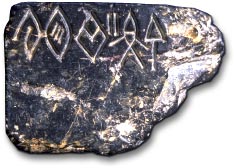 Most of these titles are obscure and are yet to be satisfactorily interpreted. However, prima facie, it is somewhat strange that so many titles of the king should end with the non-masculine suffix -(a)mpu/-(a)mbu. A possible explanation is that the words themselves are grammatically in the neuter gender, though they serve as birudas (honorific titles) of the king. I can illustrate this by citing an interesting Old Tamil loan-word in this list, Katun-ter-ambu, which may be compared with katun-ter'fast chariot' occurring frequently in the Tamil Cankam poetry (e.g. Puram 15:1). This is also the likely explanation for the word Nagabu, lit., 'serpent' (neu.) but serving as the proper name (masc.) of a stone-mason (in the Amaravati pillar inscription). Even at present we have neuter nouns serving as proper names (masc.) in Tamil as in Tiruccirrampalam.
Most of these titles are obscure and are yet to be satisfactorily interpreted. However, prima facie, it is somewhat strange that so many titles of the king should end with the non-masculine suffix -(a)mpu/-(a)mbu. A possible explanation is that the words themselves are grammatically in the neuter gender, though they serve as birudas (honorific titles) of the king. I can illustrate this by citing an interesting Old Tamil loan-word in this list, Katun-ter-ambu, which may be compared with katun-ter'fast chariot' occurring frequently in the Tamil Cankam poetry (e.g. Puram 15:1). This is also the likely explanation for the word Nagabu, lit., 'serpent' (neu.) but serving as the proper name (masc.) of a stone-mason (in the Amaravati pillar inscription). Even at present we have neuter nouns serving as proper names (masc.) in Tamil as in Tiruccirrampalam.It is however a moot point whether this situation can be extrapolated to the Harappan times, though the possibility cannot be ruled out.
An important consequence of the determination of the functional and phonetic values of the ARROW sign is the bearing it has on the value of the JAR sign, its more frequent functional twin. As is well known, the JAR sign is by far the most frequent in the Indus Script, and determining its value is critically important for the decipherment of the Indus Script.
Since the ARROW sign has been shown to be the non-masculine singular suffix *-(a)mpu, it follows almost automatically that the JAR sign must be the masculine singular suffix with the phonetic value *(a)nru, a result which is virtually independent of the pictorial value of this sign. This in turn leads to the recognition of the sign of the plural which can be shown to alternate with the JAR and ARROW signs in similar contexts. While I propose to deal more fully with these matters in another paper, I am anticipating the results here to indicate the importance of the present determination of the phonetic value of the ARROW sign.
